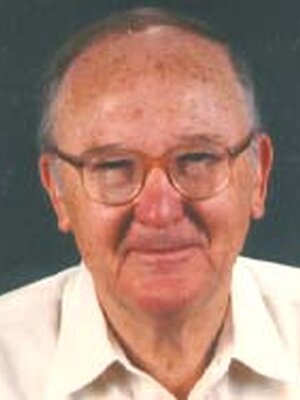
Herbert Sander Gutowsky's pioneering work made nuclear magnetic resonance spectroscopy one of the most effective tools in chemical and medical research. Born November 8, 1919, on a produce farm in Bridgman, Michigan, Gutowsky was the son of Otto and Hattie Meyer Gutowsky. He claimed that his childhood experiences taught him the importance of hard work, which carried over to his scientific life. An avid bicyclist and bird-watcher who later became very interested in growing roses, he was a quiet man who focused on science.
Gutowsky received a bachelor's degree from Indiana University in 1940, and after a four-year interruption for military service, he was awarded a master's degree from the University of California at Berkeley in 1946. Gutowsky earned his PhD in chemistry from Harvard University under George Kistiakowsky and joined the faculty of the University of Illinois in 1948. He became a full professor in 1956. His research interests as a young faculty member included molecular and solid-state structure and infrared and radio frequency spectroscopy, including nuclear magnetic resonance and electron paramagnetic resonance.
Gutowsky was a pioneer in the field of nuclear magnetic resonance (NMR) spectroscopy, showing how this technique could be used as an important experimental tool for studying the structure and dynamics of molecules in solids, liquids, and gasses. He was the first chemist to apply the NMR method to chemical research, and his investigations into the principles of NMR and its uses had a monumental effect on virtually all scientific investigations requiring the analysis of molecular structure. In short, Gutowsky's breakthrough discoveries made NMR one of the most important spectroscopic tools in chemical and biochemical research.
Gutowsky and his students made great advances, discovering the phenomenon of spin-spin coupling and recognizing its utility for the assignment of structure. He was the first to show how NMR line shapes could be used to determine details of the motion of molecules. Over his career, he steadily increased the breadth of studies of the structure and dynamics of molecules, the origin of chemical shifts in NMR spectra, and the use of NMR to identify complex organic compounds. He built his own apparatus to perform his first NMR experiments, and his work led directly to decisions by companies, especially Varian Brothers, to sell NMR spectrometers commercially, now a billion-dollar industry.
UI chemistry professor Paul Bohn said that Gutowsky's principal contribution "was to show how magnetic resonance spectral lines could be used to gain information about the structure of small molecules. He revolutionized the way synthetic chemists characterized the products of their reactions, and had a widespread and deep impact on the whole field of chemistry." UI physics professor Charles Schlicter said "He was reserved but deeply devoted, deeply interested in chemistry. It just occupied his mind. He had a terrific ability to see new areas that should be studied."
Gutowsky became head of the Department of Chemistry at Illinois in 1967, and in 1970 he oversaw the creation of the School of Chemical Sciences, which included the departments of chemistry and chemical engineering. He served as Director of the School of Chemical Sciences from 1970 to 1983. He then returned to teaching and research, moving into a second research career in Fourier-transform microwave spectroscopic studies of small, weakly bonded molecules in the gas phase. He died January 13, 2000.
Gutowsky's many achievements were recognized by his election to the National Academy of Sciences, the American Academy of Arts and Sciences, and the American Philosophical Society. He was also elected a fellow of the American Physical Society and of the American Association for the Advancement of Science.
Gutowsky received many awards, including two from the American Chemical Society, the Irving Langmuir Award in Chemical Physics in 1966 and the Peter Debye Award in Physical Chemistry in 1975. He was also awarded the prestigious National Medal of Science in 1977 and the Wolf Prize in Chemistry in 1983. He was appointed a fellow of the University of Illinois Center for Advanced Study in 1983, and received the Pittsburgh Spectroscopy Award in 1992 and the John Kuebler Award of the Alpha Chi Sigma professional fraternity.